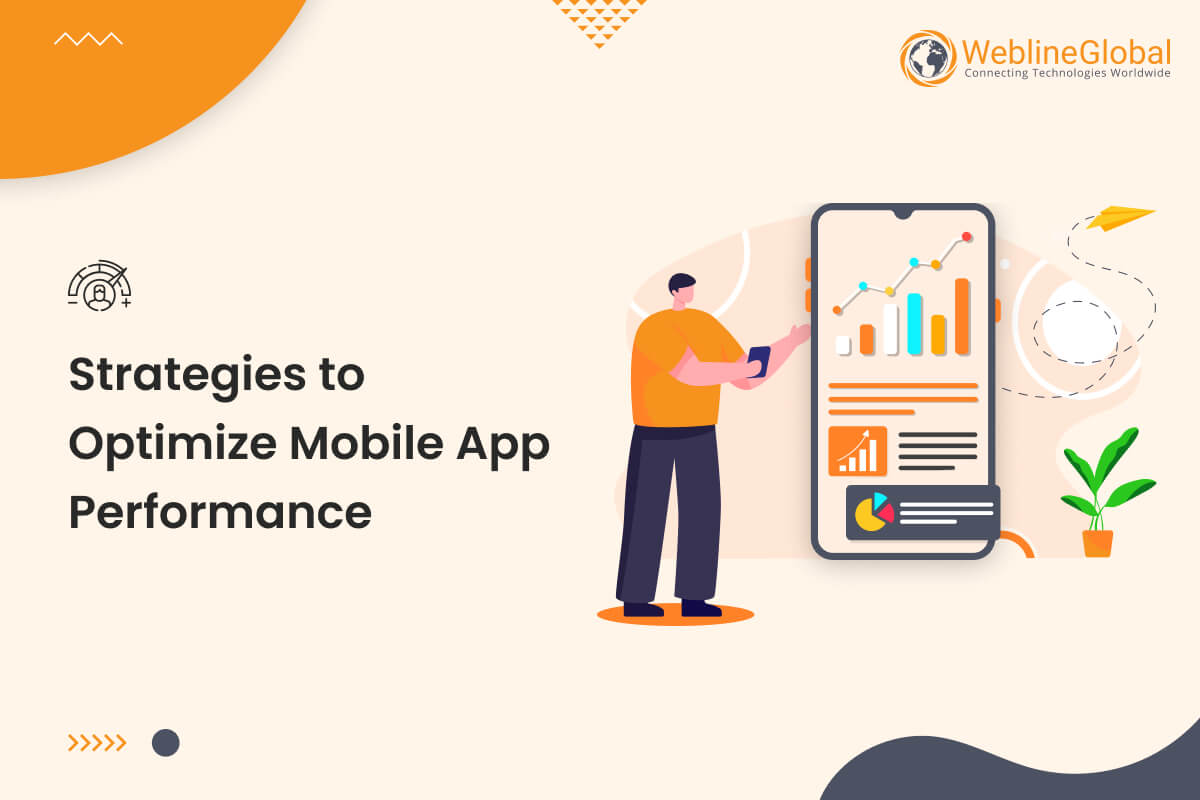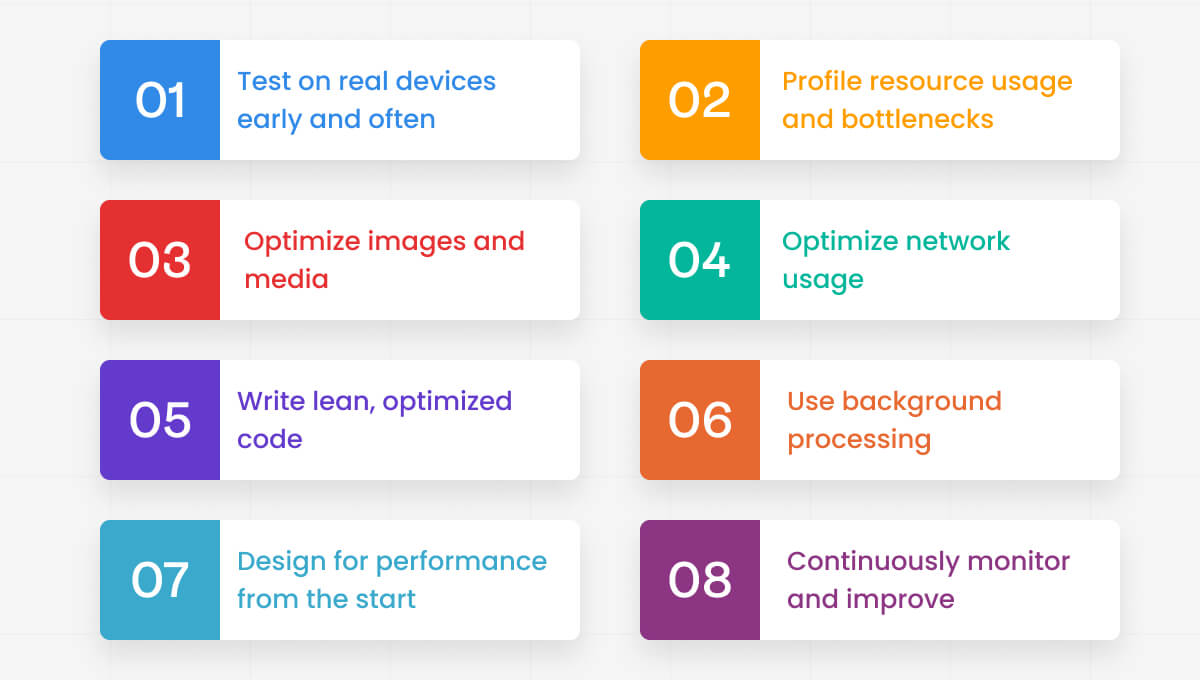
In today’s crowded app market, performance is everything. With over 8 million apps in the major app stores, users have endless options and little patience for slow, buggy experiences. Even an extra second of load time can result in reduced usage and poor reviews. Optimizing your app for maximum speed and fluidity is essential. But where do you start? Here are the top techniques for mobile app performance optimization to enhance your mobile app’s speed and fluidity.
Best Strategies to Optimize Mobile App Performance for Peak Efficiency
1. Test on real devices early and often
The simulator can only take you so far. To gauge mobile app performance, you must test on physical devices and as early in development as possible.
- Each device and OS has its performance characteristics. Testing on various real devices helps uncover issues you would miss on the simulator alone.
- Keep a test device lab on hand with different models across OS versions. Pay attention to both high and low-end devices, as performance problems often appear more clearly on older or underpowered hardware.
- Test on devices regularly throughout the dev cycle – don’t wait until the end! This allows you to isolate and address problems early before they become major.
- Pay extra attention to performance during alpha and beta testing. Bug reports from users provide real-world data on areas for improvement.
2. Profile resource usage and bottlenecks
Your app may seem fast during development, but hidden costs in mobile app development can surface when it slows to a crawl under real user data. To catch these issues early, optimize app performance as you add features and data.
- Use the profiler tools built into Xcode and Android Studio to measure memory usage, CPU load, network requests, and other vital signs as you interact with the app. The profiler reveals processes that consume excessive resources so you can optimize.
- Profile on different devices to uncover hardware-dependent issues. Your code may run smoothly on the latest iPhone but struggle on a 5-year-old budget device.
- Analyze performance data over time as you add features. New functionality often introduces performance drag. Nip problems in the bud before they become entrenched.
- Load test with production-level data to reveal scaling issues. An app may handle a few records smoothly but choke once the database grows.

3. Optimize images and media
Images, graphics, and other media are often the biggest performance hogs. Optimizing and loading media efficiently is key to fast rendering.
- Use appropriate resolutions – don’t load huge images for small thumbnail views.
- Compress image file sizes without sacrificing quality.
- Use efficient formats like JPEG for photos, PNG for simple graphics, and GIF/WebP for animations.
- Lazy load non-critical images so they don’t slow the initial launch. Load only as the user scrolls.
- Use image sprites where appropriate to avoid multiple network requests.
- Cache images locally after the first load.
- Use CDNs to distribute media quickly across regions.
- Load lower-resolution placeholders first, then high-res images.
The same principles apply to video, audio, 3D models, and other media. Tweak resolutions, compression, and loading strategy for optimal delivery.
4. Optimize network usage
Mobile networks are often slow, unreliable, and metered. To minimize network lag:
- Only download data needed for the current view – don’t grab everything upfront!
- Compression network requests and responses using gzip/deflate standards.
- Cache frequently accessed data locally – avoid repeat network requests.
- Use content delivery networks (CDNs) to distribute resources closer to users.
- Make requests asynchronously so they don’t block UI.
- Queue non-urgent requests to go out at optimal times.
- Optimize request size – download chunks vs. huge files when possible.
- Retry failed requests with exponential backoff.
- Check if data is stale before re-fetching from the network.
- Use efficient data formats like JSON that parse quickly.
Smart network management keeps response times nimble even on spotty connections.
Also, read the blog on Top Mobile App Development Trends
5. Write lean, optimized code
Sloppy, unoptimized code bloats apps and slows them to a crawl. Avoid performance pitfalls with:
- Clean, efficient algorithms – don’t repeat expensive operations.
- Avoid memory leaks – release objects when no longer needed.
- Minimize render-blocking operations like complex CSS and JavaScript.
- Lazy load non-critical components – initialize only as needed.
- Limit DOM depth and complexity – simplify when possible.
- Debounce rapid-fire events like scroll to prevent overload.
- Don’t block the main thread – use background workers for heavy lifting.
- Batch similar operations to reduce overhead.
- Avoid unnecessary polling and notifications. Only refresh when data changes.
- Write critical components natively for maximum efficiency.
Well-structured, optimized code keeps CPU and memory churn to a minimum.
6. Use background processing
Don’t block valuable main thread time on heavy processing. Offload non-critical work to background threads:
- Perform data caching and prefetching in the background.
- Make network requests asynchronously.
- Do image processing and filtering off the main thread.
- Save data changes to disk in the background.
- Use JobScheduler on Android and BackgroundTasks on iOS to defer work.
Background processing prevents UI freezes and delivers buttery smooth performance.
7. Design for performance from the start
It’s much easier to build a fast app than to optimize a slow one. Keep performance in mind throughout the design process:
- Start with lean, focused features that load quickly. Avoid bloat.
- Design a simple, lightweight UI without unnecessary bells and whistles.
- Plan caching, prefetching, and loading from the beginning.
- Define performance budgets for CPU, memory, and network usage.
- Simulate slow networks and devices to uncover weaknesses.
- Test performance early and often across the dev lifecycle.
Apps designed for speed stay lean as new features are added.
8. Continuously monitor and improve
App performance optimization is an ongoing process. Continuously monitor real-world performance and respond quickly to changes:
- Track frame rate, memory usage, and network requests in production.
- Monitor crash and ANR rates. Dig into spikes to find and fix root causes.
- Listen to user complaints about speed or freezing. Address weak spots.
- Update inefficient libraries and third-party SDKs. Don’t let old code slow you down.
- Keep up with new browser and OS improvements. Take advantage of speed boosts.
As devices and networks evolve, so must your optimization efforts. Mobile app performance is never “complete”!
Conclusion
To conclude, mobile app performance optimization is essential as it impacts user experience, engagement, and, ultimately, app success. Enhancing app code, utilizing the caching mechanisms, and using native features can help you improve your mobile app performance.
In addition, collaborating with reputable mobile app development services by WeblineGlobal can get you an advisor who will ensure that your app works well and meets the users’ needs. Do not allow performance regressions to limit your app’s success; contact our app development service provider today to help your app get the most out of its capacity and enhance your business. Act quickly and see how a top-notch mobile application will perform its magic.





